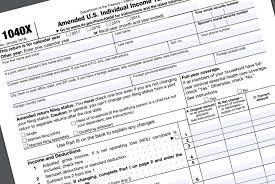
Made a mistake on your tax return or realize you lost a valuable deduction or tax credit? You can file an amended tax return to correct it. Filing an amended tax return with the IRS is a simple process. This article includes step-by-step instructions on when and how to amend your tax return using Form 1040-X.
Mistakes happen, even in tax returns. Therefore, the IRS allows taxpayers to correct their tax returns if they find an error in a return that has already been filed. Here's what you need to know about filing an amended tax return.
When to file an amended tax return
There are times when you need to correct your return and times when you don't. Here are some common situations that might need you to file an amendment:
You forgot to report your taxable income on your tax return.
You mistakenly claimed the wrong filing status.
You need to remove or add a dependent.
You realize that you cannot claim a tax deduction or credit.
You realize that you claimed an expense, deduction, or credit for which you were not eligible.
Generally, you do not need to file an amended tax return if you find mathematical or clerical errors in a newly filed tax return. The IRS will usually correct these errors on its own and, if necessary, send you an invoice for the additional fees owed or a refund if the error is in your favor.
Before submitting an amended tax return, make sure the IRS has already processed the tax return you need to amend. This way, you can ensure that the IRS does not confuse your original return with your amended return. If you have already received your tax refund, you know that the IRS has already processed your tax return.
Please note that the IRS limits the time required to file an amended return to claim a refund for:
Within three years of the initial filing deadline, or
Within two years of paying the tax due for that year, if applicable later.
If you are outside this window, you will not be able to request a refund by amending your tax return.
How to file an amended tax return
The process of filing an amended declaration is quite simple. Here is a step-by-step guide.
Step 1: Gather your documents
Collect your original tax return and any new documents needed to prepare your amended tax return.
If you need to correct the income reported on your return, you may have a new or amended Form W-2 or Form 1099. If you did not claim a tax deduction or credit, you would need documentation proving the new deduction you are claiming, such as a charitable donation receipt, the new or amended Form 1098 Statement of Mortgage Interest, or Form 1098-T to claim an education credit.
If you cannot find a copy of your tax return, you can request a copy of your tax return using the Get Transcript on IRS.gov. Your transcript shows most of the lines on your tax return, including earnings, deductions, credits, and tax payments.
Step 2: Get the right forms.
The IRS amendment return form is Form 1040-X. You will also need any form that will be affected by your change. For example, if you change your itemized deductions, you will also need a copy of Schedule A for that fiscal year. A copy of Schedule B is required to amend the tax return to add additional interest or dividend income. Changes to business income or expenses will require Schedule C and Schedule SE. Updating capital gains and losses will require Form 8949 and Schedule D etc.
Step 3: Complete Form 1040-X
Form 1040-X contains three columns:
Column A: This column shows the numbers previously reported on the tax return. Use the copy of the tax return you collected in Step 1 to complete this column.
Column B: This column shows how your initial performance values should increase or decrease. For example, if you change your gross income to include $50 of interest income missing on your previous tax return, you would enter $50 on line 1, column B.
Column C: This column displays the correct value. Add the values from column A and column B and enter the result here.
In Part III of Form 1040-X, you must provide a clear explanation of why you submitted an amended return.
Step 4: Submit your Amended Forms
Starting in 2019, you can file amended tax returns electronically.
To amend a 2018 or earlier return, you will need to print the completed Form 1040-X and any other amending forms. Attach all necessary supporting documents, such as:
Any new or amended W-2 or 1099 forms
Other forms or schedules that have changed, such as Schedule A, if you updated itemized deductions
Your CP2000 notification if you modify your tax return following a notification received from the IRS
Send all forms and documents to the address given in the instructions.
If changing your tax return results in higher fees, you will have to pay additional tax. You can mail a check with the amendment. Instead of waiting for the IRS to send you an invoice by making a payment now, you can minimize interest and penalties.
Please note that if you file an amended tax return on paper instead of electronically, it may take eight to 12 weeks for the IRS to process the change. Can you check the status of your amended return using IRS Where's My Amended Return? Please allow approximately three weeks from the date you submitted your return for the information to appear in the IRS system.
If you amend your federal tax return, you may also need to file an amended state tax return. Each state has its form of amending the tax return.
FOR MORE INFORMATION ON HOW ROSOVICH & ASSOCIATES, INC. CAN BEST HELP YOU WITH YOUR TAX FILING NEEDS, PLEASE CLICK THE BLUE TAB ON THIS PAGE.
THANKS FOR VISITING.
Rosovich & Associates, Inc.